My Top Ten games were difficult to separate. I ordered and re-ordered this list numerous times but I’ve finally settled on this list. My top three (or is that four?) were never in doubt. The rest of them I hold in such high regard that I’d play any of them any time. So, without further ado…
10 – Legendary Encounters: The X-Files
Upper Deck (2018) – Designed by Ben Cichoski & Daniel Mandel – 1-5 Players
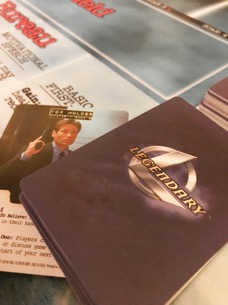
I love The X-Files. I could write that another hundred times and it still wouldn’t get across how much. Growing up I wanted to wear a trench coat, carry a badge and hunt aliens. Somehow, that vision of my future didn’t happen, but I still love this show.
I’ve played The X-Files Board Game, but it didn’t quite give me that feeling. But when I heard rumours that an X-Files Legendary Encounters game was in the works my interest was piqued. I waited and waited for it to be released and didn’t wait a second to pick it up and, thankfully, it was worth the wait.
This game drops you deep into the world of Mulder, Scully, Skinner and co. and is incredibly thematic for a deck-builder. Each game is customisable, allowing you to choose the make-up of your bureau deck and the season from which your enemies will herald. For me, I’m going to play from 1 to 9 in order and replay the series in my mind.
I desperately hope that Upper Deck support this with expansions.
9 – Stone Age
Z-Man Games (2008) – Designed by Bernd Brunnhofer – Art by Michael Menzel – 2-4 Players
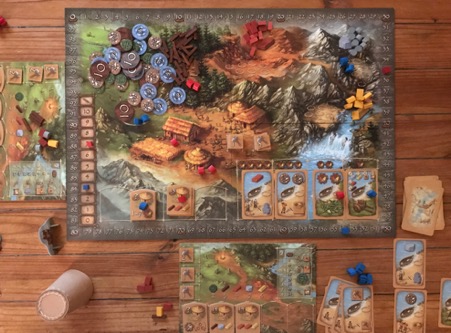
Stone Age, for me, is the classic and pure worker placement game. It may look like there’s an awful lot going on here and, in fairness, there is. The board has numerous locations – six different types of resource, a central village with three other locations, three stacks of tiles, four spaces for cards, and each player has their own player mat with spaces within which to place these tiles and gather your worker tokens.
The scoring system, too, certainly has the potential to get heads spinning as you sum a long list of numbers, multiples of how many of one thing you have and another thing you have. Trying to keep a track of how many builders you have and how many buildings you have built and whether you would be better off taking a pottery card, could have the potential to send people into analysis paralysis.
But none of that matters when you get into the flow of the game. The turns are divided into two halves – take turns putting your workers out on the board, then take turns bringing them back and taking the relevant action. The ease of explaining how this game works means that I can introduce it to anyone and everyone.
While this is a game in which you can adopt and appreciate a number of strategies, you must adapt throughout the game in order to win. Because you’re rolling dice to obtain resources, sometimes you roll well and sometimes you don’t. Do you play it safe and stick all your men on the gold space, or push your luck and hope you roll well? This is a great game, a classic, and I always enjoy it.
8 – TIME Stories
Space Cowboys (2015) – Designed by Peggy Chassenet & Manuel Rozoy – 1-4 Players
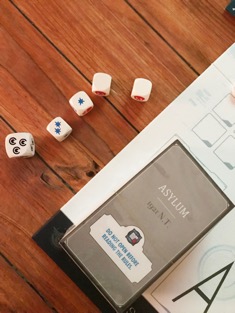
There are a number of games on this list which score serious points because they tell a story as you play them, but nothing trumps TIME Stories on that front.
TIME Stories sat on my shelf for quite a while, unplayed, because I was waiting for a co-op opportunity to bring it out, but that opportunity never presented itself. So, I decided to give it a go solitaire instead, and I’ve not looked back since.
I can still remember the sensation of awe and wonderment when I played that fateful first game of TIME Stories, how you were drawn into this unfolding world and narrative, how you had free reign to explore the map at your own pace… until the time runs out. After finishing, and failing, my first game, I immediately went back in for more. Each time you play, you find out something new, and the game is constantly teasing you back in. What would have happened if we did this instead next time?
The system is so simple, and once you know what you’re doing you can play any of the expansions. But each expansion is different in its own way, and asks different questions of you as you work your way through the deck. Because of this, I don’t think I will ever grow tired of TIME Stories.
7 – Terraforming Mars
Stronghold Games (2016) – Designed by Jacob Fryxelius – Art by Isaac Fryxelius – 1-5 Players

Terraforming Mars landed with a splash in 2016, instantly making an impact and picking up a nomination for the 2017 Kennerspiel des Jahres. Since then we have seen regular expansions to feed people’s thirst for more of this game.
On the face of it, this looks like a heavy Euro game, with over 200 unique project cards, different corporations to play, progress tracks for temperature and O2 levels, and a map of Mars with spaces for hexagonal lake, forest or city tiles, player boards to track resources and production, and cubes, lots of cubes.
This, unsurprisingly, is a game about terraforming Mars – taking it from a cold, dry, baron planet to a warmer, developed landscape with oxygen producing plants and forests. You score points each time you increase the terraform-rating of any of the three key measures.
As well as competing for point-scoring positions on the map, the game plays out on your player board as well. Your player board is where you will move, spend and convert your cubes, seeing your engine in action, building up to a thrilling conclusion as you near the end of the game.
Building your engine and racing towards the target terraform ratings is a great strategic challenge. For bonus points, this game also has a great solitaire mode which challenges you to terraform Mars in 14 turns.
I have written a solo review of Terraforming Mars here.
6 – Rising Sun
CMON (2018) – Designed by Eric Lang – Art by Edgar Skomorowski & Adrian Smith – 3-5 Players
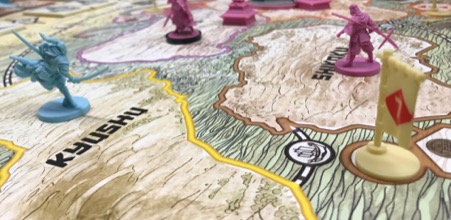
Rising Sun was the eagerly anticipated ‘spiritual successor’ to Blood Rage. Like its predecessor this is an area control game that plays over three main rounds (seasons), but this game relies heavily on negotiation and forming alliances.
As you’d expect with a CMON product, this game contains stunning art and incredible miniatures. On the table this is certainly an impressive setup.
Play is asymmetric as each clan has its own unique abilities, and it’s very important to manage your position on the honour track (which is used as the ultimate tie-breaker throughout the game), and recruit Oni (spiritual demons) to complement your strategy.
At the end of each season a series of battles will occur in a pre-determined order around the map and this is where your strategic mettle will be tested. Battles take place using a blind-bidding system, in which you can bid for the ability to sacrifice your fighters, take an opponent hostage, hire Ronin and write poetry about the battle for victory points.
This game is deeper and longer than Blood Rage, and I think you could spend a lifetime exploring its strategies.
5 – Star Wars: Rebellion
Fantasy Flight Games (2016) – Designed by Corey Konieczka – 2-4 Players
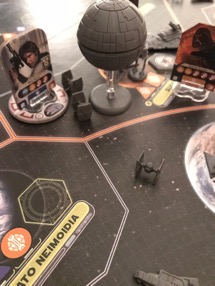
As I eluded to in number 24, there was going to be more Star Wars on this list. I haven’t played Imperial Assault but, if I had, I’m sure it would be in here somewhere.
But, there’s no better Star Wars experience that Rebellion, is there? The so-called Star Wars-in-a-box game.
This game really does invoke the feeling of being part of the rebellion trying to thwart the Empire whilst trying to keep a lid on your anxiety as they draw ever closer, or
the feeling of the might of the empire trying to hunt down the rebel base.
The box is filled with so many tiny X-wings, Y-wings, TIE fighters, Death Stars, Stormtroopers and rebel troopers, as well as being a deep, asymmetric game, this also brings out the toy factor too. It’s a long game, and a big investment time-wise, but if you’re a Star Wars fan then you simply must give this a go.
There’s a solitaire mode available on BGG, which gives you an artificial intelligence in place of the Empire which isworth checking out, but this game is definitely best as a two-player game.
4 – Blood Rage
CMON (2015) – Designed by Eric Lang – Art by Henning Ludvigsen & Mike McVey & Adrian Smith – 2-4 Players
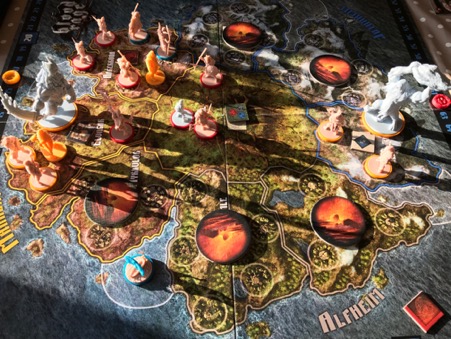
I had to think hard to separate Blood Rage and Rising Sun, and Blood Rage eventually came out on top. Of course, I love every game that is this high up the list, but I’ve had so many great games of Blood Rage that it had to win out.
Blood Rage was the first board game that tempted me to back a Kickstarter, and I’m so glad that I did. The game is so slick, so tightly balanced, so interactive. You spend your Rage each turn to upgrade your clan, invade or march into provinces on the map, or pillage a province for various rewards.
As the game progresses your clan (and your opponents’ clans) will become stronger – you will have more rage to enable you to perform more actions, you will be able to place more warriors on the board and you will receive more points for winning battles. At the end of each age one of the provinces will be destroyed, closing the game board in over the course of the game, forcing you to interact with other players.
Blood Rage plays quicker, but still contains as much depth, as Rising Sun. After repeated plays you get to know the battle cards and upgrade cards that are available, and this plays into the psychology of battles and drafting your cards each turn.
Once you start paying Blood Rage, you might find yourself playing it over and over again. I’m delighted that a digital version is coming later this year.
3 – Pandemic / Pandemic Legacy
Z-Man Games (2008/2015) – Designed by Matt Leacock & Rob Daviau– 1-4 Players
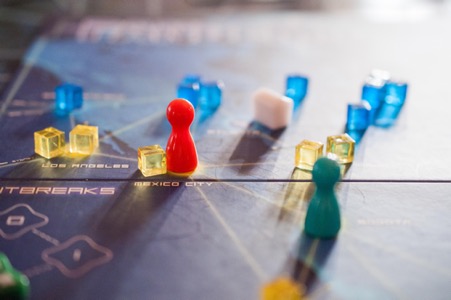
The classic co-operative game, Pandemic, was ten years old last year but it still hits my table often. I play it solo, at varying character-counts, and love to collect statistics on how each character performs.
Every game is unique – from where infection, epidemics and outbreaks occur, in what order, to the characters you play and the cards and events you draw. Through playing this over one-hundred times I’ve developed an overall strategy that I usually follow, but I still need to react differently to different developing situations with each new play.
I may be cheating here, by also including Pandemic Legacy at the same spot. I love the Pandemic base game, but having recently also started Legacy Season One, this has only added to the experiences that I already enjoy. I won’t spoil Pandemic Legacy here, but the introduction of the legacy deck, permanent changes to the board, etc. not only give this game an immensely deep narrative, it almost makes it cinematic.
This is a game that has inspired so many others, and I’m looking forward to completing Legacy Season One this year and hopefully moving onto Season Two.
2 – Scythe
Stonemaier Games (2016) – Designed by Jamey Stegmaier – Art by Jakub Rozalski– 1-5 Players
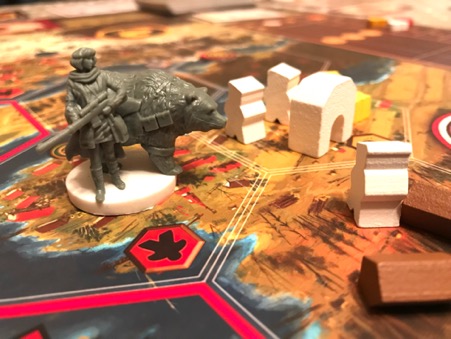
In at number two, and one of only two games I’ve given a 10/10 to on BGG, is Scythe. This is a beautifully produced work of art. The game art creates an immersive world in which to play the game. The custom, wooden, playing pieces and plastic miniatures are a joy to play with. The dual-layered player boards are a fine touch, and show the care Jamey Stegmaier takes with his games on behalf of his players.
Scythe is set in a world with asymmetric factions, creating and trading for resources, building mechs, upgrading their abilities and possibly entering into combat to protect their land.
Despite what it looks like from afar, this isn’t necessarily a game of war and combat. This is an economic game of building up your faction to suit your board position, available resources, and the position of your opponents. This game has a wonderful progression as the game goes on. To begin with your are very limited in what you can achieve, but towards the end of the game your can perform multiple actions on your turn and push towards picking up stars.
Once someone picks up their sixth star (for completing all of their upgrades, building all of their mechs, completing a hidden objective, winning battles, etc.) then the game ends immediately. However, having that sixth star doesn’t guarantee victory. Instead, you score your money, resources, control of hexes on the map, and placement of your buildings. Whoever has the most money/points at the end of this is the winner. So, timing when you pick up stars and keeping an eye on your opponents is critical to your success.
As well as being a great multiplayer game, Morten Monrad Pedersen has also developed a great Automa system which plays very differently to the main game, and also poses a great challenge to players of all levels.
This is a simply fantastic game and I can’t get enough of it.
I have written a full review of Scythe here.
1– Twilight Struggle
GMT Games (2005) – Designed by Ananda Gupta & Jason Matthews – 2 Players
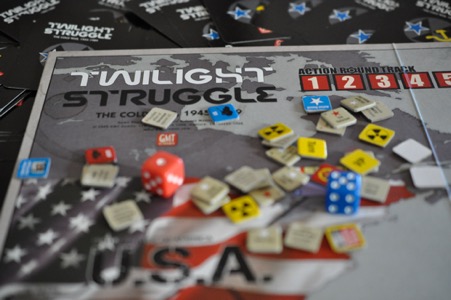
My number one is the game that really got me into strategy gaming and will forever hold a place in my heart. But this game isn’t number one simply for sentimental value or nostalgia. This game is number one because it is the most intense, thematic, head-to-head battle of bluffing and forward planning that I think you can get.
Twilight Struggle is immense, and re-tells the post-world-war story of the Cold War – USA versus USSR. Perform operations around the globe to realign other countries to your agenda, encourage coups, place your own influence and try to beat your opponent in the space race. Or use historic event cards to your advantage. Just watch out for events that will help your opponent.
As you play more, and become familiar with the cards and events that occur in the early, mid or late-war, your strategy and anxiety deepens. Worrying about what cards your opponent might have, and keeping half an eye on the DEFCON track, will drive you to paranoia.
Each card contains an event that might benefit you, your opponent or both sides, and also an operations points value. You have the choice of using the points or the event, but if the event is aligned to your opponent then it happens regardless. Hence, a handful of cards that strongly benefit your opponent can be a daunting prospect. But you need to keep a straight face to ensure your opponent doesn’t sense your weakness.
Each continent has its own scoring card which will come out at some point in the game. If you have a scoring card in your hand you must play it before the end of the turn, even if you are behind. However, signposting that you have a certain scoring card in your hand is likely to lead your opponent to strengthen in that area.
Finally, if the DEFCON track reaches one on your turn you lose, which can happen as a result of coups in battleground states or card effects. Meaning that when DEFCON reaches 2, tensions are heightened.
Yes, this is only a two-player game, and it can take a while to play, but it is such a fantastic game that I will never turn it down – my number one.

One thought on “My Top 25 Games: 10 to 1”